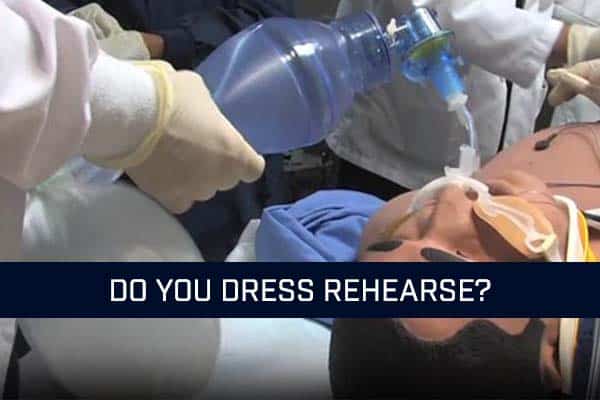Thoughts from a Clinician: DO YOU DRESS REHEARSE?

Any professional actor, actress, or performer will tell you the most important part of their job is the dress rehearsal. It makes sense…right? They go in full costume garb and perform as if there’s a full audience, with one major exception – there are no paying customers watching! They do this to perfect, in every way, their show, assuring that the customer will be fully satisfied. This logic also applies to the critical care provider. Are you doing it? I challenge the current provider to ask themselves – Am I “dress rehearsing”? If yes, then “how often” and under what circumstances? If not, why not? Are we practicing for the main stage? Let’s put on our EMS shades and examine how this applies to us. Current providers are the performers; our stage – the patient’s living room; the audience – our patients. Stop and think about this…and then continue reading!
Too much training is still being done without simulation. The value-added component of simulation is nearly immeasurable, especially for the critical care provider. As commonplace as it has become, simulation still gets the hairy eyeball from some. Perhaps the pushback comes from the cost of simulation or simply the available resources to do simulation training (1). How do we combat this kind of pushback in our shop? How do we influence the training and education to ensure that simulation is included? Do we start weekly or monthly “dress rehearsals?”
One myth, I suspect, is that to do “engaging” critical care simulation, it needs to be done in and with a high-fidelity scenario and manikin. This is not true. According to Sydney Area HEMS Education Coordinator Cliff Reid, MD, a lot of simulation is about stimulating the mind to believe what is happening (2). The correct phrase for this simulation is called “stress inoculation” training. The military has done this very well for many years and is starting to make its way into civilian EMS. For example, the military has done stress inoculation training to ensure that all Soldiers, Sailors, Airmen, and Marines can function fully despite extreme stressors. In essence, the extreme stress replaces the “high fidelity” capability of the manikin, essentially eliminating the need for a very expensive high-fidelity simulator (3). Use what is available at your station and training area, then pour in several gallons of stress. Watch the “simple” simulation unfold as it becomes a high-stakes, reality-based inferno of experiential potential.
Some might ask what the recipe is for the “stress.” I might offer that “stress” comes in two parts; first, the scenarios must be believable and relatable; second, there must be specific benchmarks the crew must hit to complete the simulation. It may help to have co-workers as actors who play the part of stressed family members. Perhaps you could throw a difficult airway on top of the patient in the extremis. These are just a few examples of the difficulties they may experience in the field – adding stress to the already-stressed mind. Remember, the goal is not to focus on the mistakes but on the opportunities for improved growth and development. Stress first; debrief last!
Remember the dress rehearsal analogy? Let’s get back to it. During rehearsal, there are almost always stagehands, directors, assistants, (etc.), hanging around, watching and perfecting their roles in the performance; the point is, the actors are being watched – by their peers. For the critical care provider, this is no different. Typically, simulations are run with and among your colleagues. The fear of failure in front of peers can be paralyzing. Suck it up, cupcake! Get over it! As understandable as this, it holds no place among us. A wise man once said, “it is better to screw up in front of each other during a training session than to underperform for a patient during their time of distress.” Each simulation training is an opportunity to learn, grow, and improve as a clinician; and an organization.
Simulation training is a valuable tool and should be implemented within your organization. This is applicable to ground, air, or intra-hospital. Go ahead; do your scenarios, add some stress, and track the results. Wear your uniform, use your equipment, and work with your partners. This is your dress rehearsal for your big stage event – taking care of the sickest of the sick. We need to be prepared to provide the best patient care…always. I promise you will see a difference.
Contact other resources to see what they can offer you and how you can be better prepared for patient care (4). If resources are needed to do this in your service, let us know how we can help. With that thought, take care and, as always, think like a clinician!
References
(1) Mora A, Tsai-Nguyen G, Columbus C. 213. Critical Care Medicine. 2015;43:54-55. doi:10.1097/01.ccm.0000474041.11341.66.
(2) https://sydneyhems.com/
(3) Naumann DN, Bowley DM, Midwinter MJ, Walker A, Pallister I. High-Fidelity Simulation Model of Pelvic Hemorrhagic Trauma: The Future for Military Surgical Skills Training? Military Medicine. 2016;181(11):1407-1409. doi:10.7205/milmed-d-16-00008.
(4) http://www.flightbridgeed.com

